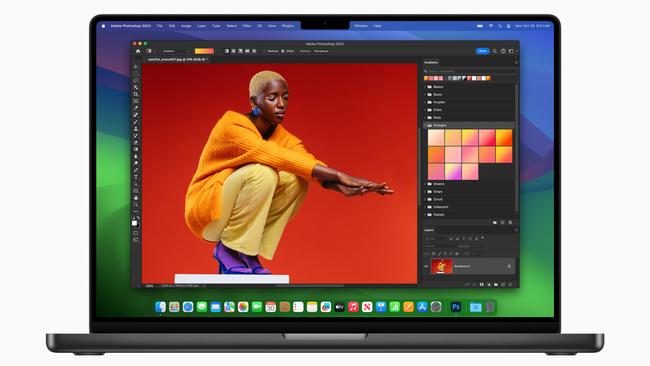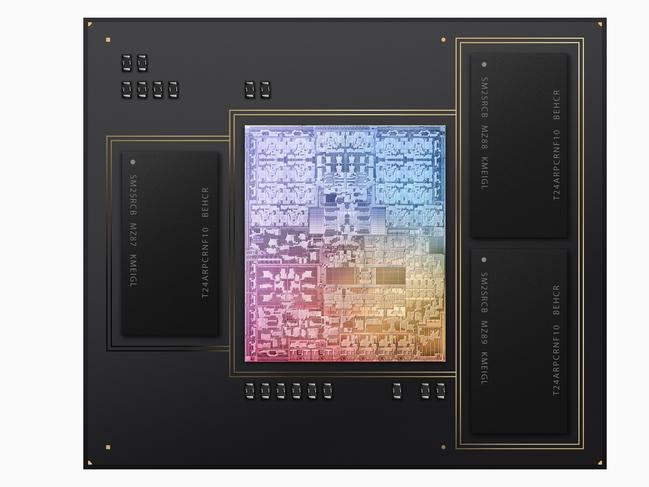Need for speed: Apple makes big reveal in latest Macbook Pros and iMac
They may look the same on the outside but inside Apple has unveiled three new chips in its latest Macbooks, which it says offer ‘extremely fast performance’.

Apple has unveiled three new chips ahead of the busy Christmas season for its 14 and 16 inch Macbooks as well as a new iMac, saying they deliver rendering speeds up to 2.5 times faster and use less power than previous generations.
The release comes a month after rival Microsoft upped the ante in the computing speed war, declaring its new Surface Pro was almost twice as fast as Apple’s M2 Max chip at an event in New York.
Apple said on Tuesday that its new chips — an M3, M3 Pro and M3 Max — were the first built using 3-nanometer process technology. If that’s a mouthful, the Cupertino-headquartered company said it simply meant more transistors could be packed into a smaller space – about allowing greater speed and efficiency.
In the case of the M3 Pro, that’s 37 billion transistors and an 18-core GPU. The M3 Max increases this count to 92 billion.
How that translates to real world use? Apple says it means you will get up to 22 hours battery life, be able to able to stream higher resolution video - thanks to a new media engine - and more photorealistic graphics.
They also support up to 128gb of unified memory, which Apple says “unlocks workflows previously not possible on a laptop”.
While there were some wild rumours that the latest computers would herald the return of the glowing Apple logo on the rear of the laptop screen — which it axed in 2015 — the new devices are largely unchanged from their predecessors, although there is a new colour: space black.

Instead Apple focused on what was under the hood. Apple’s senior vice president of Hardware Technologies Johny Srouji said the new M3 family of chips represents the “largest leap forward in graphics architecture for Apple silicon”.
“Apple silicon has completely redefined the Mac experience. Every aspect of its architecture is designed for performance and power efficiency,” Mr Srouji said.
“With 3-nanometer technology, a next-generation GPU architecture, a higher-performance CPU, faster Neural Engine, and support for even more unified memory, M3, M3 Pro, and M3 Max are the most advanced chips ever built for a personal computer.”
Apple has switched from Intel chips to its own M chips over the past three years. As a result, its computers are cooler, faster, quieter and more durable. This has left Windows PC manufacturers largely playing catch-up.
But the lack of an external update may disappoint some - hence Apple’s focus on speed, efficiency and a more immersive experience.
For example, a new media engine now includes support for AV1 decode - a new way in which videos are compressed, creating higher quality images at the same bitrate. This means better streaming.
The new GPU architecture also introduces hardware-accelerated ray tracing - a type of rendering technique that models the properties of light as it interacts in a particular scene. This creates more realistic and accurate images.
“This, along with the new graphics architecture, allows pro apps to deliver up to 2.5x the speed of the M1 family of chips. Game developers can use ray tracing for more accurate shadows and reflections, creating deeply immersive environments,” Apple said.

“Additionally, support for up to 128GB of memory unlocks workflows previously not possible on a laptop, such as AI developers working with even larger transformer models with billions of parameters.”
Overall, Apple said the CPU performance and efficiency cores are 30 per cent and 50 per cent faster than those in M1 respectively, and the Neural Engine is 60 per cent faster than the Neural Engine in the M1 family of chips.
But Apple said the extra horsepower was also better for the environment. A higher level of energy efficiency helps the new MacBook Pro achieve the longest battery life in a Mac — up to 22 hours. “This results in less time needing to be plugged in and less energy consumed over its lifetime,” the company said.
Apple is also inching closer to ensuring all of its operations achieve net-zero emissions as the world’s biggest tech companies race to become greener. At Apple, this means making more of its products carbon neutral, including its Apple Watch range and “every chip in every mac”.
The new computers are available for pre-order in Australia and will be on store shelves from November 7, priced from $2699 for the 14 inch MacBook Pro and $4299 for the 16 inch models. The iMac with 8-core CPU, meanwhile, starts at $2199.




To join the conversation, please log in. Don't have an account? Register
Join the conversation, you are commenting as Logout